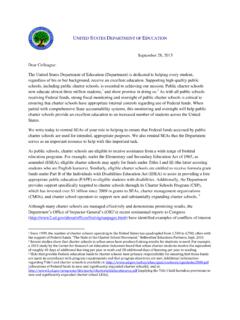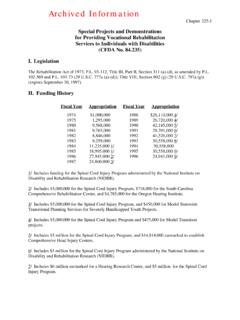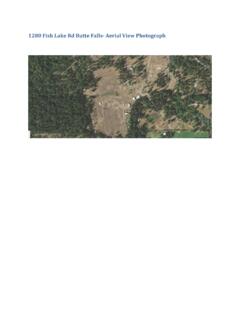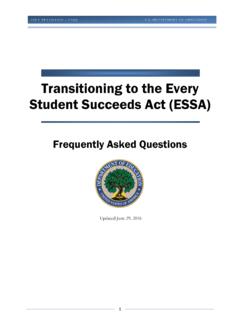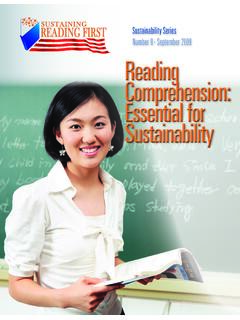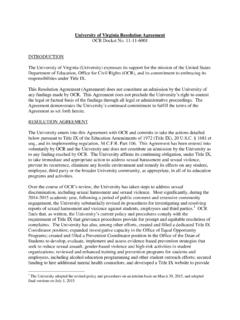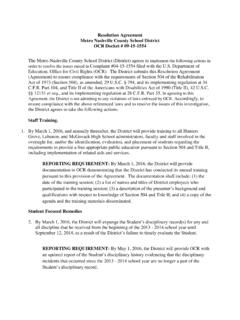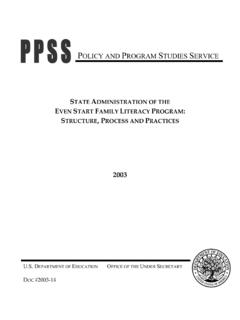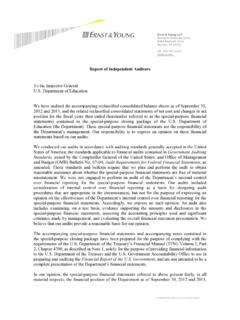Transcription of Non-Regulatory Guidance: Ensuring Educational Stability ...
1 Non-Regulatory guidance : Ensuring Educational Stability for Children in Foster Care Department of Education and Department of Health and Human Services guidance on the Foster Care Provisions in Title I, Part A of the Elementary and Secondary Education Act of 1965, as Amended by the Every Student Succeeds Act of 2015 June 23, 2016 Under the Congressional Review Act, Congress has passed, and the President has signed, a resolution of disapproval of the accountability and State plans final regulations that were published on November 29, 2016 (81 FR 86076).
2 This guidance document is unaffected by that resolution and remains applicable. 2 Table of Contents Introduction .. 3 Purpose of the guidance .. 3 Frequently Asked Questions .. 6 Educational 6 School of Origin .. 11 Best Interest Determination .. 11 Dispute Resolution .. 14 Transportation .. 15 Immediate Enrollment and Records Transfer .. 20 State and Local Points of Contact .. 21 Student Data and Privacy .. 23 Collaboration .. 25 Appendix: Sample POC Notification Letter .. 28 The Department of Education and Department of Health and Human Services do not mandate or prescribe practices, models, or other activities in this Non-Regulatory guidance document.
3 This guidance contains examples of, adaptations of, and links to resources created and maintained by other public and private organizations. This information, informed by research and gathered in part from practitioners, is provided for the reader s convenience and is included here to offer examples of the many resources that educators, parents, advocates, administrators, and other concerned parties may find helpful and use at their discretion. The Departments of Education and Health and Human Services do not control or guarantee the accuracy, relevance, timeliness, or completeness of this outside information.
4 Further, the inclusion of links to items and examples do not reflect their importance, nor are they intended to represent or be an endorsement by the Departments of Education and Health and Human Services of any views expressed, or materials provided. 3 Purpose of the guidance Introduction Children and youth in foster care represent one of the most vulnerable student subgroups in this country. Of the approximately 415,000 children in foster care in 2014, nearly 270,000 were in elementary and secondary Studies find that children in foster care are much more likely than their peers to struggle academically and fall behind in school.
5 Students in foster care at age 17 are also less likely to graduate from high school, with only 65 percent graduating by age 212 compared to 86 percent among all youth ages 18 to A recent study found that children in foster care in California scored lower on assessments and showed less progress in scores over time compared to peers of similar backgrounds who were not in foster Children in foster care experience much higher levels of residential and school instability than their peers; one study showed that 75 percent of children in foster care made an unscheduled school change in one school year, compared to less than 40 percent for children not in foster Unplanned school changes may be associated with delays in children s academic progress, leaving highly mobile students potentially more likely to fall behind their less mobile peers Children experiencing this type of 1 Adoption and Foster Care Analysis and Reporting System (AFCARS) FY 2014 data.
6 2 National Youth in Transition Database. Unpublished analyses (April 2016). Administration on Children, Youth and Families, HHS. 3 National Center for Education Statistics (2014). Digest of education statistics, 2014 - table Retrieved from 4 Frerer, K.; Sosenko, ; Pellegrin, N.; Manchik, V.; & Horowitz, J. (2013). Foster youth Stability : A study of California foster youths school and residential changes in relation to education outcomes. Retrieved from 5 Ibid. 6 National Working Group on Foster Care and Education. (2014.) Fostering success in education: National factsheet on the Educational outcomes of children in foster care.
7 Retrieved from The Department of Education and Department of Health and Human Services have determined that this guidance is significant guidance under the Office of Management and Budget s, Final Bulletin for Agency Good guidance Practices, 72 Fed. Reg. 3432 (Jan. 25, 2007). See significant guidance is non-binding and does not create or impose new legal requirements. The Departments are issuing this guidance to provide State and local Educational agencies with information to assist them in meeting their obligations under the Elementary and Secondary Education Act.
8 If you are interested in commenting on this guidance , please email us your comment at or write to us at the following address: Department of Education Office of Elementary and Secondary Education 400 Maryland Avenue, Washington, 20202 For further information about the Department s guidance processes, please visit 4 instability, including many students in foster care, are thus more likely to face a variety of academic Recognizing the unique needs of children in foster care, States and the Federal government have launched efforts in recent years to increase the Educational Stability of and to improve Educational outcomes for these youth.
9 The passage of the Fostering Connections to Success and Increasing Adoptions Act of 2008 (Fostering Connections Act) was a significant step towards supporting the importance of school Stability for children in foster care in Federal law. The legislation requires child welfare agencies to collaborate with Educational agencies to keep children in foster care in the same school when living placements change, if remaining in that school is in their best interest. The Fostering Connections Act also requires child welfare agencies to ensure that children in foster care who do change schools are promptly enrolled in a new school, with the relevant school records.
10 The Department of Health and Human Services (HHS) issued guidance on the Fostering Connections Act in July HHS and the Department of Education (ED) have worked together over the years to assist agencies in improving their policies and programs in order to better serve children in foster care. In November 2011, HHS and ED hosted a national convening9on the education of children in foster care, entitled Child Welfare, Education and the Courts: A Collaboration to Strengthen Educational Successes of Children and Youth in Foster Care. Leaders from the State and tribal child welfare agencies, State Educational agencies (SEAs) and the State juvenile courts created State action plans to strengthen Educational supports and services for children in foster care.
